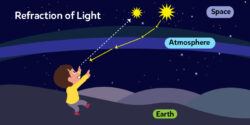
We all love stargazing, watching them twinkle in a clear night sky. But have you ever seen planets appearing to twinkle too? You must have then wondered why or how this happens? Scientists and experts have found that sometimes planets do appear to twinkle to unnoticeable degrees. You might observe planets twinkling if you spot them low in the sky. That is because, in the direction of any horizon, you would be looking through more atmosphere than when you look overhead. Imagine if you could see stars and planets from outer space. You would notice both shining steadily as there would be no atmosphere to disturb the steady streaming of their light. However, due to a lot of atmospheric factors, planets do not usually twinkle but stars do. Let’s now try to understand that in detail.
While observing stars in a clear night sky, you will see them twinkle.
There is a technical term for this: astronomical scintillation, an effect caused due to our planet’s atmosphere. As light travels through the blanket of air around our planet, it is diffracted or in simple terms, bounced around, causing a quick apparent dimming and brightening — what we call a twinkle. While some stars are found to physically change in brightness over time, they typically do so over a longer time period. Astronomers monitor these changes sometimes for hours, but more often for days, weeks, or even numerous years. A major scientifically defined phenomenon that causes stars to twinkle is known as atmospheric refraction.

Atmospheric refraction is the phenomenon behind the twinkling of stars. Light from the stars on entering the Earth’s atmosphere undergoes refraction and hence causes the twinkling of stars.
The term atmospheric refraction refers to the deviation of the straight light rays caused by the atmosphere. Atmospheric refraction is mainly caused due to variation in the density of air in the Earth’s atmosphere.
When a light ray passes through the atmosphere, the variation in the density of air changes the deviation of the light rays every single time. Due to this, the source of light seems to shift down or up and can often stretch or shorten. This is what gives out a twinkling effect. When stars or even a planet refract a larger amount of light, they appear bright whereas when they refract a lesser amount of light, they look dim. And that’s why they appear to twinkle!
Here is a video that will help you better understand the refraction of light. It is the same refraction that causes the twinkling of the stars.
Planets are much closer to the Earth when compared to stars. Due to their relatively closer distances, planets have a finite size when being observed from the Earth. Stars on the other hand, are further away and hence, a beam of light coming from a star appears much smaller than a beam of light from a nearby planet. Thus a star’s smaller light beam is more noticeably bent in the atmosphere, causing twinkling, whereas the light beam from a planet generally does not appear to move at all. This is why stars twinkle and planets do not.
Nearby planets appear like tiny disks in the sky. This would be seen much better and with more clarity with a telescope than with the naked eye. If you see through a telescope, planets will appear as tiny disks while stars look like points. Planets and their apparent sizes are usually said to be larger than the pockets of air that would distort their light, so the diffractions cancel out and the effects of astronomical scintillation are negligible.
Hence, to sum it up, planets do not twinkle because:
Technically planets do twinkle but not in a way that is noticeable to our naked eye. This is because unlike stars plants do not produce any light of their own and instead reflect the light falling on them from our sun. The light reflected by planets is of low intensity and of a steady nature. On top of this their distance from Earth is relatively small and hence appear much larger in size than than the stars that are lightyears away. The atmospheric refraction caused on the light from these planets are negligible and hence planets do not twinkle.
If you want to observe planets in a bit more detail you would need a telescope. Not to worry you can learn how to make a telescope at home!
Have you ever seen planets twinkle like stars? Tell us more about your experiences in the comments below.
Enjoyed reading this? Also check out these reads from The Learning Tree Blog: Why Do Some Plants Eat Insects?
Why Do We Need A Standard Meridian For India?
NASA’s Perseverance Creates History, Collects First Rock Samples from Mars
Writing has always been Shreesha’s passion, be it for imparting knowledge or expressing opinions. In her former role as a journalist, she contributed to enriching society with knowledge. Now, at BYJU’S, she has moved on to something more exciting – creating tailor-made content for students. When she is not writing, you would find her looking for new ways to engage her child.